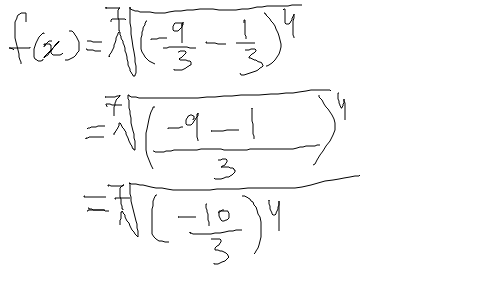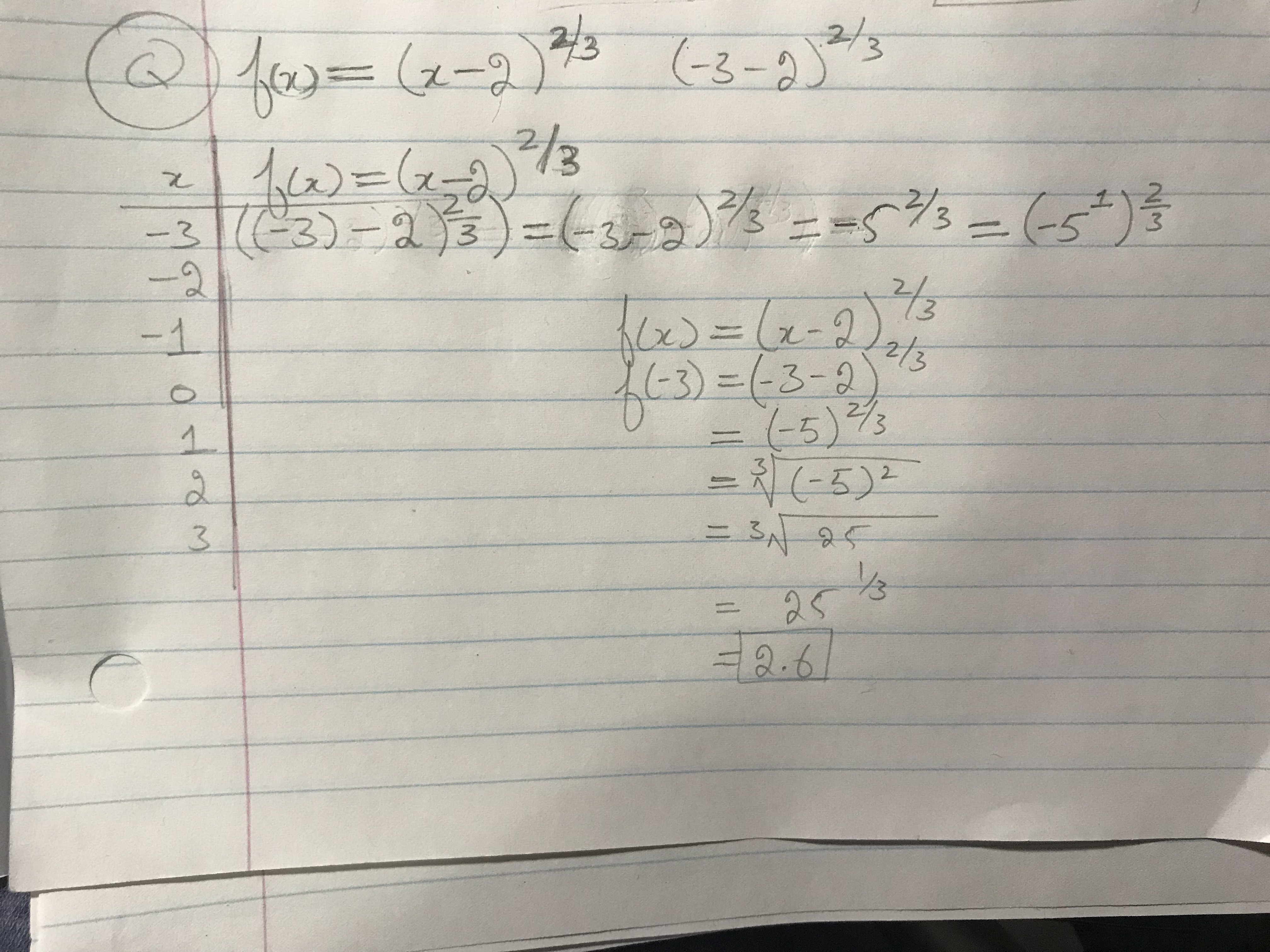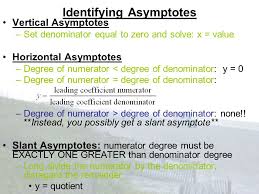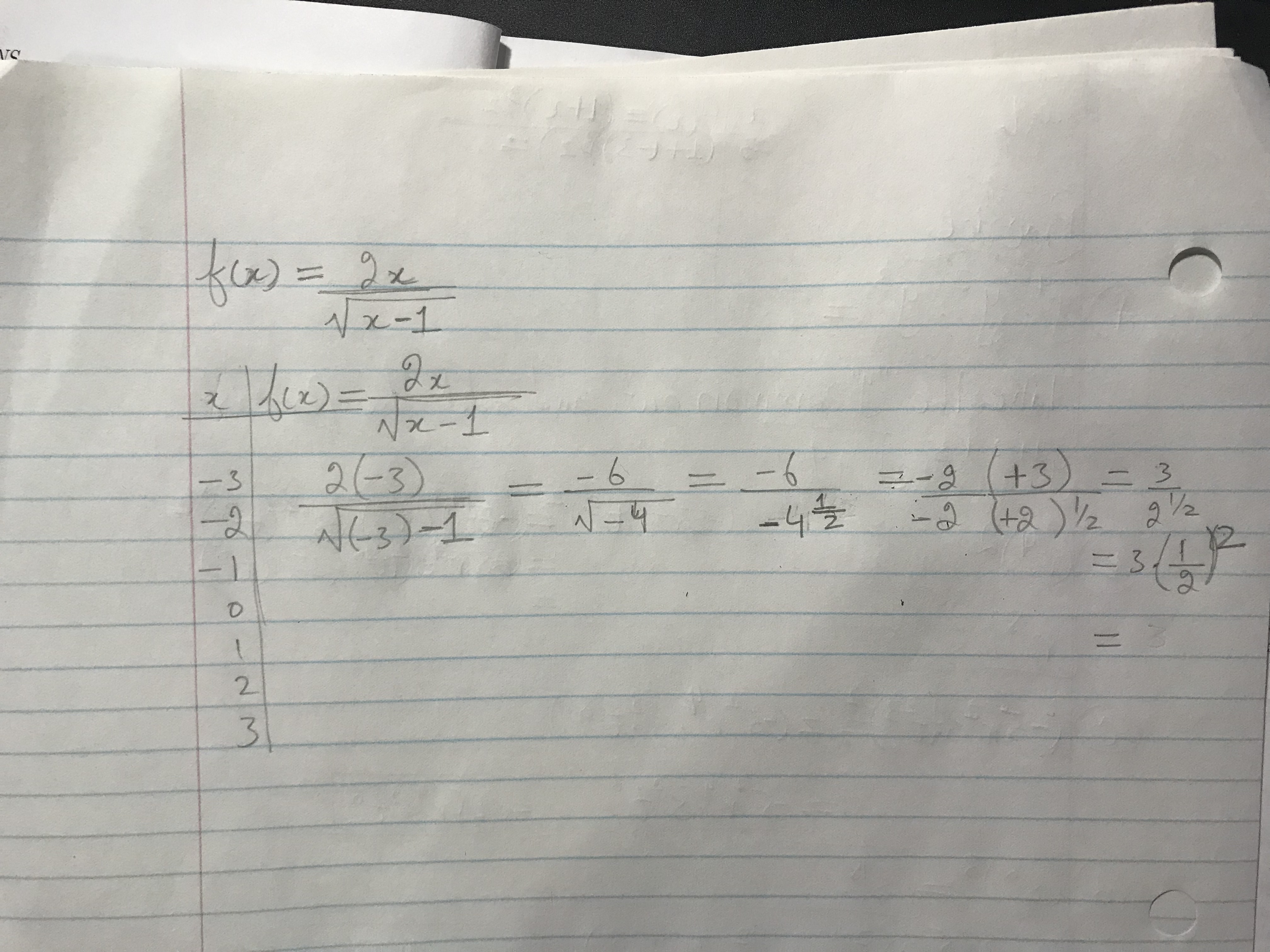can someone algebraically show me how to plug and chug for every x value into the function? i'm having hard time dealing with power functions. wait let me draw tho.
|dw:1560604650881:dw|
|dw:1560604785561:dw|
If you want to find the value of f(x) when x is, say -3, here's what you would do: f(x)=3x- 1/3 You want to find when x=-3. The algebraic notation for this is f(-3). Replace the x variable with the value, -3. 3(-3) - 1/3 You can try this and you'll get your answer. Apply the same thing for the other values.
what do u mean *apply the same thing on the other side*? be more specific plz :)
"Apply the same thing for the other values" Do the same for f(-2), f(-1), etc.
im having trouble with powers... ..wait i'm drawing it out for u. 1 sec
Oh, I couldn't tell that was an exponent.
That changes all the values. Ignore what I said earlier Let me explain:
|dw:1560605857906:dw|
For the sake of Santa clause...i’ll Draw out the question more clearly. 1 sec
No, you made a mistake in the second step. The power applies to the entire binomial.
|dw:1560606147071:dw|
Ok wait, let me try one more time... wait and check my second attempt
Recall that if a power is a fraction, the numerator is the power and the denominator is the index of the radical.
Sure
Don’t do the question for me. Let me struggle myself. Just correct when when am wrong
Sure, do you want a suggestion though?
|dw:1560606291768:dw|
You're getting a step closer. Now the '4' should go inside the radical and around the binomial.
First comes power, then comes root.
What do u mean by *the denominator is the index of the radical*?
So do I switch the 4 and 7?
Index of a radical is like \[\sqrt[index]{n}\]
What you're rooting it by. In this case it's 7
Oki dokie
Wait, let me write it out again
Sure
|dw:1560606573981:dw|
Correct.
Omg I’m shoooo happy. I’m finally learning to do these without the calculator lol thanks mate...wait let’s continue 😀
np
|dw:1560606790085:dw|
|dw:1560606926145:dw|
Do I take the sq root of q23 and then multiply by 7?
Do you have an option in your calculator?
No you wouldn't do that
One second. Let me try that. U confirm if it’s right or wrong. I jus wanna see what happens
Sure
77.7.6 lol
What single steps do I plugin into my calculator to find the right answer?
Okay that would be wrong
let me check your calculator model and see
Is it a scientific/graphic calculator or normal?
Ofc it’s a scitific calculator mate 🙂😇
But jus really really old
There should be an option like \[\sqrt[x]{ }\]
I have an option of....wait let me draw
Maybe look up a tutorial for it and figure out where that option is. I don't have a casio calculator so I'm not sure about how they work
sure
|dw:1560607391240:dw|
Wait. What’s the answer mate?
It's okay, I think you can still do it without a calculator.
The answer is like 3.5
3.58
Whole dawn... let me try some stuff
Here's what you'd need to do without a calculator: Apply a principle of exponents: \[(\frac{ x }{ y })^{n}\] = \[\frac{ x^n }{ y^n }\]
Sure
So you would do that for the radicand.
|dw:1560607637712:dw|
No, let's go back to where we had (-10/3)^4
\[\sqrt[7]{(\frac{ -10 }{ 3 })^4}\]
Apply the principle I just showed you.
|dw:1560607832415:dw|
|dw:1560607914842:dw|
|dw:1560607952007:dw|
No, only for the radicand. Don't do the 4/7
It should be \[(\frac{ -10 }{ 4 })^4\]
|dw:1560607981083:dw|
We are applying this principle within the radical
It's fine
Ok ok ok ok... so right right we r only solving what’s within the root?
For now, yes. ...Also, I just noticed you made a mistake WAY earlier
|dw:1560608075951:dw|
Wait, let me take the first stab at this plz
Yes yes but wait a second. You got the radicand portion wrong and I failed to notice. My apologies. -9-1/3 isn't -10/3
It's -28/3. You didn't take the correct common denominator.
-9 would be -27/3. Do not fret, these mistakes occur often. Just make sure you don't take simpler portions of a problem lightly.
So now you have (-28/3)^4
|dw:1560608170099:dw|
\[\sqrt[7]{(\frac{ -28 }{ 3 })^4}\] Without using a calculator, we would first evaluate the radicand.
Correct, you're on the right path. Keep going
|dw:1560608342406:dw|
But the parenthesis should go to the denominator as well
Correct
Now apply the principle I showed you earlier to the radicand
|dw:1560608384306:dw|
Correct
|dw:1560608448048:dw|
Correct
|dw:1560608499888:dw|
Yes. That is also correct, you're just switching the form.
Got em!
Do you want to simplify it more?
Now here’s the issue with my calculator....watch.
It won't be much, and usually, this form is accepted as well.
Sure
|dw:1560608606309:dw|
I need to right down this whole question on a paper. Brb. Your a legend mate. I think I should call u Jesus from here nwo
On*
I have more fraction power questions tho. I was suppose to find their domains and ranges ....i was plugin in different ‘x’ values into the function to plot the graph...and my crappy calculator would gimme stupid answers. Thanks tho
Ah okay. For domain and range I suggest you take the limits (RHL and LHL) of them or it would take too long. There's 1 discontinuity there.
Now I’m getting the right answers. Wait let me post the picture lol
Or you should graph them. Using test points here would take too long as the discontinuity is really small and hard to pinpoint with a test point.
sure
before, everytime i plugged in *-5^2/3* i'd get an error lol
Calculations are correct, but using test points for these types of complex functions would take too long just saying. Also if there's a discontinuity, you won't be able to pinpoint it with test points.
do i need to buy a better calculator or something?? to be able to get the *y* values faster?
Do you have a graphing calculator? It would help you tons to find the domain and range. Otherwise, you'd need to use calculus.
i dont wanna buy a fancy TI tho. cuz the uni wont let me use it in midterm and finals...sooo
Do they allow a TI-83/84
It's a pretty basic graphing calculator
pff, they won't even let me enter college with that calculator mate
TI-83 or TI-84??? u can literally graph anything on those things
weight, i have more questions. i'll be back in 2 minutes. gotta finish this question :)
sure
can u see it?
So the domain is all real numbers?
Yes.
What about range? All real numbers except y<0
Sorry y has to be greater than 0
Correct but y≥0
0 is inclusive
Yes my bad. I’m doing it with u on the fly
Just saying, using test points won't always work. For example, if you get a question like: \[\sqrt{x^2 + 1/3}\] There would be a discontinuity
sure
I actually do have questions like that and even more funnier looking stuff
okay, yes here you would then need to know asymptotes and discontinuities of functions.
Testpoints don't always work.
Because there might be a discontinuity all the way at x=928, for example
So what variables in the numerator and denominator decide where the asymptote(s) and discontinuities r
So for this question...
|dw:1560610500842:dw|
I'll explain:
For that function, there is no discontinuity
I know I can’t plugin 2 into the equation...cuz that’d make everything equal to zero
Just because the output is 0 doesn't mean it's a discontinuity.
So for that reason, we have a restriction in the range? Where y can’t be bigger or equal to zero.
Yes, I should not have used that question for discont and asymp
For this question, you were correct. I'm just saying for hypothetical scenarios if you get a question that has a discontinuity, test points don't work. There's a w
There's a way* to calculate asymptotes and discontinuities. Do you know them?
i think I do but wait...I have a question. When we plugging zero into the function..the whole function collapses. How do I know it’s for the domain or range....if I were to do it really fast
I do have asymptotic and restriction questions ...but i’ll Ask u those later..
I can’t make out what u just sent me...it all blurry
For domain it's the set of x values. As long as you yield an output that is not n/0, the input exists. For range, it's simply knowing the minimum or maximum and going to their approaches
Anything n/0 is undefined..got it
Yes. Otherwise, the input is considered in the domain.
Also, if the radicand is less than 0, it is also imaginary and thus undefined.
ie \[\sqrt{x-4}\] If you get a value under 4, you'll get a negative radicand. That's why the domain is x≥4. Range would be y≥0. You can use some testpoints here. Also, it would be best to know the behavior of these functions. Square root functions normally have a range greater than or equal to 0 unless it is transformed by f(x+h)+k
So if a function has a y value for any x value, it’s automatically in the horizontal domain? So if there’s no value for x...let’s say at f(2) of some function gives me an error ....means there’s an asymptote
Yes I agree with the root question...where x has to be bigger than 4 bcuz u can’t take the root of negative numbers
So does that mean I need to remember than root function graphs look like? Omg ok
Discontinuity, not asymptote. There's a thin line between the two. Discontinuity is a specific point, asymptote is more like a region or line.
And some discontinuities are removable, which is why you should know to manipulate functions
Yes. Like in limits...I got it
It's best to know the basic look of them so you can figure out if the function is transformed. Then you wouldn't need to do any work.
And no, not for all root functions, I'm just saying for like square roots. I myself don't know the behavior for cube root functions and others
Yes, in limits
I’m working on a new question. I know wanted to see what it’s like to manually solve for the y value for this function. Picture coming soon
Bad idea to use test points here. Just look at the denominator and you can get a discontinuity.
asymptote*
i just wanted to test my algebra tho :)
oh ok
i think the denominator has to do with vertical asymptote? O-o
Correct but then there's a vertical stretch in the numerator
hoesntly i havent touched math in years... im just guessing/recalling to the best of my abilities.. plz dont judge..
k so before we figure out the domain and range of the following function. And the vertical and horizontal asymptotes ...can u plz check my work real quiff? let me draw :)
|dw:1560615767676:dw|
sqrt(-4) is imaginary and thus undefined, you can't factor out a -2.
Oki 😐
That's why x=-3 for f(x) is undefined.
You can't solve any further
oki dokie
so the vertical asypmtote is at 1?
since 1 will make the denominator equal to 0
correct
any anything divided by 0 is error
That makes the domain (1, infinity)
and for the horizontal asymptote... we look at the ratios of the leading degrees. wait, let me draw
|dw:1560616332648:dw|
yes correct
wait.... i need to show u the graph... :O
but it would be an oblique asymptote
watinda heck is this?
the horizontal asymptotoe is more like at 1 tho
No, if the degree in numerator is > than denominator's, it's oblique/slant asymptote. It would be difficult to calculate here.
but i just watched the video on youtbe and he said it's *0* tho *~*
omg i mixed up... it's the opposite here. we have a bigger degree in the numerator than the denominator. sorry *~*
omg he said, if the degree of the numerator is bigger than the denominator, then there's no HA
at 5:35
yes it would be oblique, but in this case it can't be calculated as all the possible lines would be tangent
so the horizontal and oblique asymptote is null
so what do we write? 0?
you don't need to write or just say null
oki dokie :)
k the domain is all real numbers, but x has to be bigger or equal to 1
yes
as for the range, it'd be all real numbers except, y can't be equal to or less the 4
okie dokie :)
yes
It can be 4, actually.
wait, what do u get when you plug in x = 2
let's do it here actually. let me draw
|dw:1560617738594:dw|
Ok, it can be 4
D: \[X \in \mathbb{R}, x>1 \] R: \[y \in \mathbb{R}, y≥4\]
yes
I think I helped enough, someone else can take over or just post another q as I have to go.
thanks bye
this is a rational function and i need to find the domain and range of the function.
|dw:1560626310596:dw|
I’m trying to factor this bad boy for the past 3 minutes...let me post
|dw:1560626414349:dw|
So you can't factor the denominator because it is not following the rule (a-b)^2 unless you use complex numbers. Do you know how to do that? Besides, you wouldn't need to factor the denominator.
You can't factor it using real numbers/variables.
Okie dokie
If you factor it, the expression would look something like: (x-i)(x+i) where i=sqrt(-1)
Soooo how do we go about finding the vertical asymptote?
There is no vertical asymptote.
Yuhh, that’s what I get ;/
I mean there is, but it is imaginary and we cannot graph imaginary scalar or vector quantities on the cartesian plane.
But how do I make myself sure that there isn’t one?
And asymptotes only fall under the real number category, so we might as well say that this function has no vertical asymptote.
So If a variable in the denominator has the ability to make the denominator 0 at any given point, there is a vertical asymptote. If the variable in the denominator has imaginary/complex solutions, there is no vertical asymptote.
No. Let's say a denominator for any given rational equation/expression is x^2 +4. Can you tell me the roots for x?
So when I can’t factor the deno, do I just assume there r no asymptotes?
Basically for vertical asymptotes: 1. Look at the denominator only. Set the polynomial in the denominator to 0. Solve for the variable as you normally would using algebra. 2. If you get real solutions, there is a vertical asymptote and it would be that solution. 3. If you get imaginary solutions, there is no vertical asymptote.
I can try to factor that...weight, let me draw it out..one sec
No, just because you cannot factor it does not mean there is no solution. It just means the polynomial is 'prime' or cannot be factored. The decision between no asymptotes and asymptotes is decided if there is a real or imaginary number.
|dw:1560626969968:dw|
Okie dokie. I’ll note that down. Good point tho.
Correct but you don't need to factor. You can if you want. But what I would look for is a way to see how to isolate the variable. When you do that, there would be a negative number over a square root, which cannot be graphed.
Yes yes yes that’s I left it...
Brb, let me include that in my notes
Sure
As for the horizontal asymptote....we know that the leading highest power in the numerator is much smaller than the leading power in the denominator...thus...the horizontal asymptote is y=0
I'd just like to add on a point, though. In some cases, you can use manipulation and remove the imaginary component to the denominator and find an asymptote/discontinuity. Similar to limits.
I don’t need to lern that ....
if numerator<denominator then y=0 numerator > denominator no HA. but there is an oblique numerator = Denominator then HA = ratio of leading coefficients.
|dw:1560627588236:dw|
correct
Let me actually include that in my notes too...brb
Back...so the domain is all real numbers
In this case? Yes
And since there’s no V.A., ........did u see the graph tho?
It doesn’t go above 2 I believe
Wait.. le me draw
|dw:1560628157909:dw|
So how do we figure out the point of vertex?
Sorry I have to go i can help later.
Okie dokie. Have a good one
Join our real-time social learning platform and learn together with your friends!






